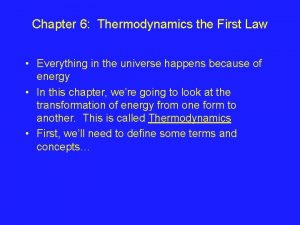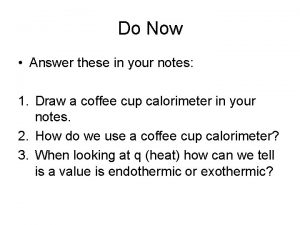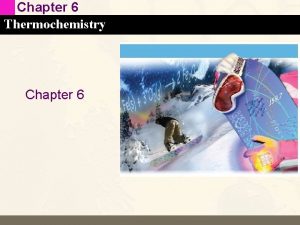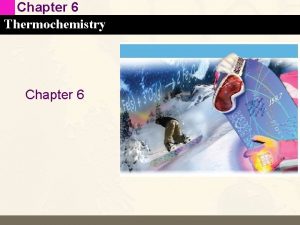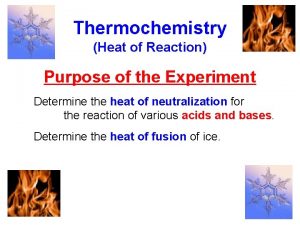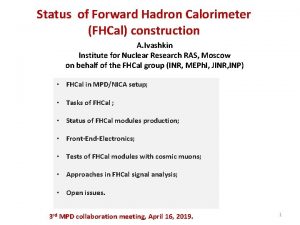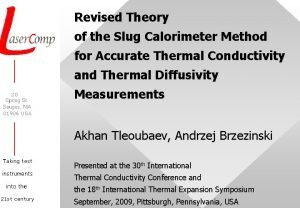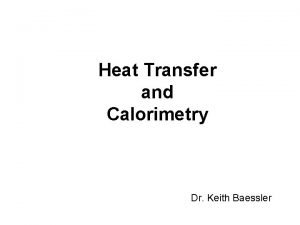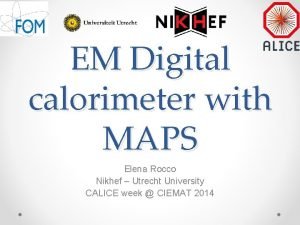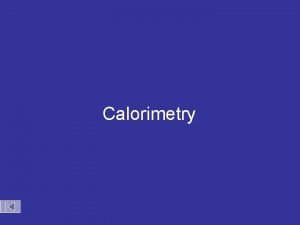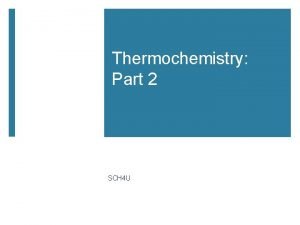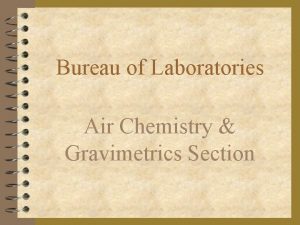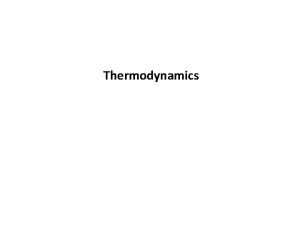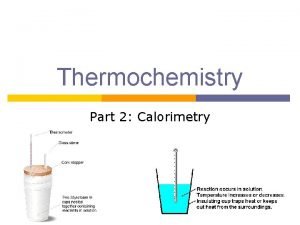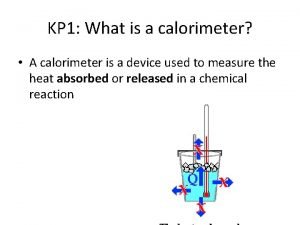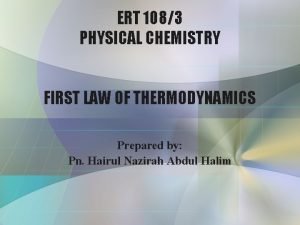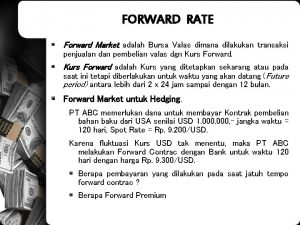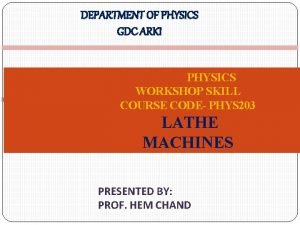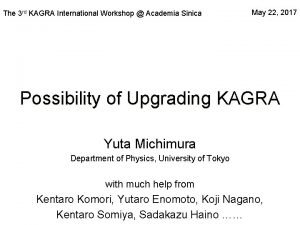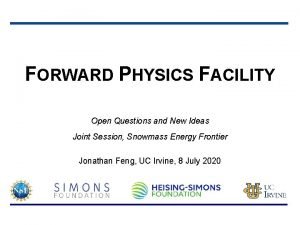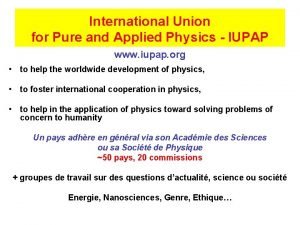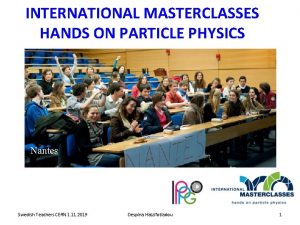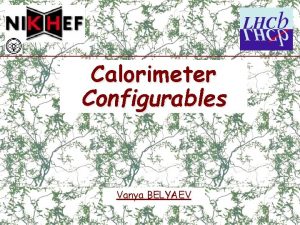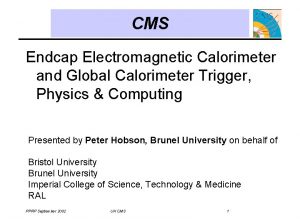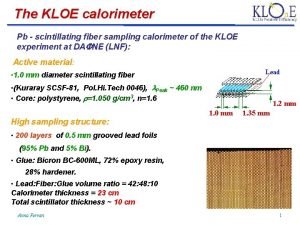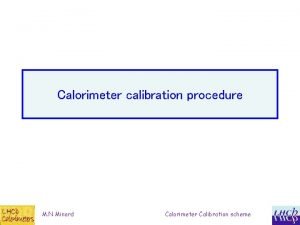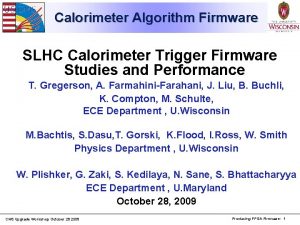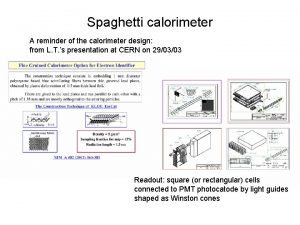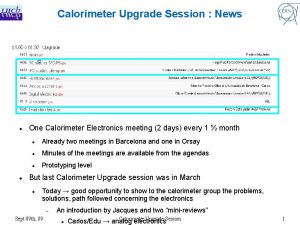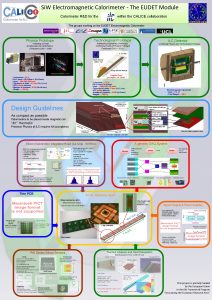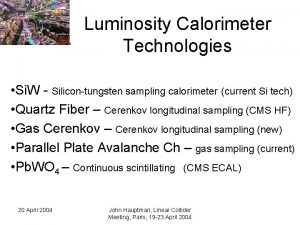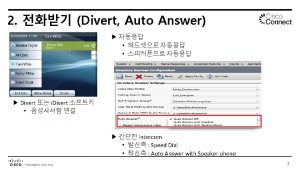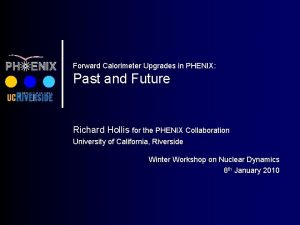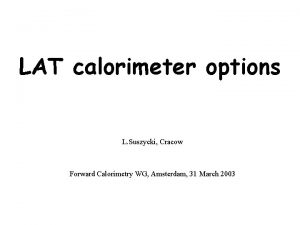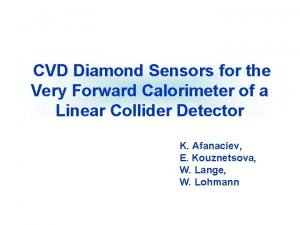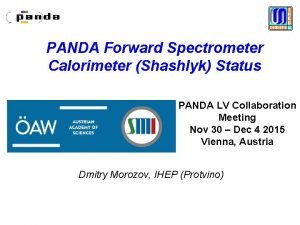International Workshop on Forward Physics and Forward Calorimeter



































- Slides: 35

International Workshop on Forward Physics and Forward Calorimeter Upgrade in ALICE CCS, Tsukuba Univ. , March 7 -9, 2019 Integrated dynamical approach from small to large colliding systems Tetsufumi Hirano (Sophia Univ. ) References: TH et al. , Prog. Part. Nucl. Phys. 70, 108 (2013). Y. Tachibana, TH, Phys. Rev. C 90, 021902 (2014); C 93, 054907 (2016). K. Murase, Ph. D thesis, the Univ. of Tokyo (2015). S. Takeuchi et al. , Phys. Rev. C 92, 044907 (2015). M. Okai et al. , Phys. Rev. C 95, 054914 (2017). Y. Kanakubo et al. , PTEP 2018, 121 D 01 (2018). A. Sakai et al. , (in preparation) 1

Outline • Introduction • Importance of dynamical modeling in high-energy nuclear collisions • Standard picture and dynamical modeling • Current situations in our group • Recent analyses • Integrated dynamical approach to soft physics in heavy-ion collisions • Fluctuating hydrodynamics • Rapidity decorrelation from hydrodynamic fluctuations • From large to small colliding systems • Dynamical initialization with core-corona picture • Enhancement of multi-strange hadrons in small colliding systems • Summary and outlook 2

Introduction Towards understanding of • Bulk and transport properties • Structure of vacuum (chiral symmetry restoration) • Electromagnetic radiation • Stopping power • Thermalization/Fluidization mechanism • New physics • … in high-energy nuclear collisions, of dynamics is mandatory. 3

Analysis tool Observational cosmology CAMB, CMBFAST, Cosmo. MC, … Cosmic Microwave Background Fluctuations of temperature (Planck) http: //www. esa. int/spaceinimages/Images /2013/04/Planck_CMB_black_background Cosmological parameters • Energy budget • Hubble constant (life time) • Curvature (flatness) • Information about inflation • … 4

Analysis tool Bottom-up approach in high-energy nuclear collisions ? Physics properties of the QGP • Equation of state • Shear viscosity • Bulk viscosity • Stopping power • … Y. Zhou, talk at QM 2018 Need for high-energy nuclear collisions 5

Standard picture of dynamics time Hadronic observables Hadron gas Recombination QGP fluid collision axis 0 interaction Fragmentation (Mini-) jets Glasma Gluon saturation Soft sector Dilute parton gas energy scale Hard sector 6

jet time (Ideal? ) Dynamical modeling hadronic observables Hadronic transport jet hadron gas Hydrodynamics QGP fluid Glasma collision axis 0 Gluon saturation Recombination model hydro+jet model string fragmentation Modification of jet structure Classical Yang-Mills CGC theory Soft sector p. QCD energy scale Hard sector 7

TH et al. (2013); K. Murase (2015); S. Takeuchi et al. (2015); A. Sakai et al. (2019). jet time Our current situation (model SOFT) hadronic observables JAM (Hadronic transport) jet hadron gas collision axis 0 Gluon saturation string fragmentation Fluctuating hydro+jet Modification of hydrodynamics model jet structure QGP fluid Glasma Recombination model Classical Yang-Mills MC Glauber(+BGK)/KLN Soft sector energy scale p. QCD Hard sector 8

Y. Tachibana, TH, (2014, 2016); M. Okai et al. , (2017); Y. Kanakubo et al. , (2018). jet time Our current situation (model SOFT-HARD) hadronic observables Hadronic transport jet hadron gas Ideal hydrodynamics QGP fluid Glasma collision axis 0 Gluon saturation Recombination model hydro+jet model string fragmentation Parton energy loss Classical Yang-Mills CGC theory Soft sector PYTHIA (Heavy Ion) energy scale Hard sector 9

Recent analyses Integrated dynamical approach to soft physics in heavy-ion collisions From large to small colliding systems 10

Integrated dynamical approach to soft physics in heavy-ion collisions (model S) hadronic observables JAM (Hadronic transport) Recombination model string fragmentation Fluctuating hydro+jet Modification of hydrodynamics model jet structure Classical Yang-Mills MC Glauber(+BGK)/KLN Soft sector energy scale p. QCD Hard sector JAM: Y. Nara et al. , Phys. Rev. C 61 024901 (2000) 11

Peralta. Ramos, Calzetta (2011), Kapusta, Muller, Stephanov (2011), Moore, Kovtun, Romatschke (2011), Hirano, Murase (2013), Young(2014), Akamatsu, Mazeliauskas, Teaney (2017)… Hydrodynamic fluctuations QGP fluid simulation in a box Courtesy of K. Murase Entropy Fluctuation-Dissipation relations State Fluctuations around maximum entropy state Dissipative hydro (2 nd Generation) Fluctuating hydro (3 rd Generation) Dissipations Fluctuations 12

Correlations along collision axis Heavy ion collision as a chromoelectric capacitor Approximately boost-invariant formation of color flux tubes Correlation embedded in wide rapidity region 13

Aligned event plane angle “Random walk” of event plane angle rapidity A. Sakai, talk at QM 2018 rapidity Factorization ratio Decorrelation from initial conditions and hydrodynamic fluctuations New opportunity to constrain and transport coefficients 14

From large to small colliding systems (model S-H)hadronic observables Hadronic transport Recombination model Ideal hydrodynamics hydro+jet model string fragmentation Parton energy loss Main purpose: from small to large colliding systems • Investigation of core-corona picture on bulk observables Classical Yang-Mills CGC theory Soft sector PYTHIA (Heavy Ion) energy scale Hard sector PYTHIA: T. Sjöstrand et al. , Comput. Phys. Commun. 191, 159 (2015). *Heavy ion mode available from ver. 8. 230 15

Bozek (2005, 2009), Aichelin, Werner (2009), Becattini, Manninen (2009), Pierog et al. (2015), Akamatsu et al. (2018), Kanakubo et al. (2018) Core-corona picture Figures: Courtesy of Y. Kanakubo Core: Chemically equilibrated QGP fluids matter Corona: Unscathed partons Low Multiplicity Key to describe dynamics High 16

Dynamical core-corona initialization Phenomenological parametrization for source term Fluidization rate per particle M. Okai et al. (2017) : Gaussian smearing : Parton four momentum : Parton position Y. Kanakubo et al. (2018) : Parton density : Control parameter : Mean free path Automatic separation between core and corona soft and hard 17

Core-corona effects on ratio of cascades to pions QGP limit: hadron production only from fluids (Chemically equilibrated matter) QGP formation dominance String fragmentation limit: hadron production only from string fragmentation Y. Kanakubo et al. (2018) 18

Size and collision energy dependence Xe. Xe (closed) vs. pp, p. Pb and Pb. Pb (open) Pb. Pb@2. 76 Te. V (thin) vs. Au@0. 2 Te. V (thick) in dynamical corecorona model Y. Kanakubo et al. (in preparation) 19

Y. Kanakubo, K. Murase, Y. Tachibana, TH (work in progress) jet time Combination of model S and S-H hadronic observables JAM (Hadronic transport) jet hadron gas Fluctuating hydrodynamics QGP fluid Glasma collision axis 0 Gluon saturation Recombination model hydro+jet model string fragmentation Modification of jet structure Classical Yang-Mills CGC theory Soft sector PYTHIA (Heavy Ion) energy scale Hard sector 20

Toward “Standard Model” from small to large colliding systems high Fragmentation from hard particles large small System size Collectivity in small systems low Collective flow from hydrodynamics 21

Summary and outlook • Development of standard model for high-energy nuclear collisions from small to large colliding systems • Current status • Rapidity decorrelation as a tool to investigate initial conditions in rapidity direction • Universal description of dynamics brought by dynamical core-corona initialization • Check list for future dynamical model in backups 22

Backups 23

Expectation to LHC-ALICE experiment Fill the blank (forward/backword) region? ! 24

Check lists towards future dynamical model • Initial conditions • Hydrodynamics • Hadronization and hadronic transport Caveat: All topics are IMHO. Some topics include long-standing problem(s) 25

Initial conditions 26

Hydrodynamics 27

Hadronization and hadronic transport ü Development of a transport theory/model between hydrodynamics and Boltzmann eq. ü Interface with hydrodynamics Beyond Cooper-Frye prescription • Negative contribution Simultaneous simulation with hydro ü Energy-momentum conservation on event-by-event basis ü Hadronization between soft and hard 28

Model S-H 2. Dynamical initialization + fluid evolution Y. Tachibana, TH, Phys. Rev. C 90, no. 2, 021902 (2014). M. Okai et al. , Phys. Rev. C 95, 054914 (2017). +Core-corona picture Y. Kanakubo et al. , PTEP 2018, 121 D 01 1. Initial parton generation PYTHIA ver. 8. 230 T. Sjöstrand et al. , Comput. Phys. Commun. 191, 159 (2015). 29

M. Okai, K. Kawaguchi, Y. Tachibana, TH (2017) Dynamical initialization in hydro models Conventional hydro simulations Vacuum Formation time of partons hydro initial time Fluids Partons “Fluidization” through source terms Energy-momentum conservation as a whole 30

Energy density and transverse flow fluctuations without core-corona picture Initial parton phase space distribution from event to event Dynamical initialization obeying momentum conservation Initial random transverse flow velocity energy density distribution transverse flow Anisotropy interpreted from initial velocity distribution random (geometry+flow) M. Okai (2018) 31

Fluidization rate Core energy at midrapidity Total energy at midrapidity Partons forced to be fluidized at the first time step Monotonic increase + saturation Core part dominance in high multiplicity events 32

33

(*Same conclusion as in, e. g. , Becattini and Manninen (2009)) Canonical suppression scenario Suppression of strange hadron yields due to absence of bath of strangeness in small systems Phi mesons are NOT suppressed See, e. g. , Vislavicius and Kalweit, ar. Xiv: 1610. 03001 34

Protons Opposite trends to exp. data • Moderate enhancement in dynamical core-corona model similar ratios both in hydro and string fragmentation • p-pbar annihilation at high multiplicity could resolve the discrepancy Need hadronic afterburner 35
 Calorimeter problems
Calorimeter problems Coffee cup calorimeter formula
Coffee cup calorimeter formula Constant volume calorimeter
Constant volume calorimeter Specific heat equation units
Specific heat equation units Constant volume calorimeter
Constant volume calorimeter Benedict's oxy calorimeter
Benedict's oxy calorimeter Accelerating rate calorimeter
Accelerating rate calorimeter Coffee cup calorimeter
Coffee cup calorimeter Dhrxn
Dhrxn Coffee cup calorimeter equation
Coffee cup calorimeter equation Combustion reaction
Combustion reaction Identify what a bomb calorimeter measures
Identify what a bomb calorimeter measures Hadron calorimeter
Hadron calorimeter Slug calorimeter
Slug calorimeter Calorimeter
Calorimeter Digital calorimeter
Digital calorimeter Calorimeter
Calorimeter Bomb calorimeter uses
Bomb calorimeter uses 62g
62g Parr calorimeter
Parr calorimeter Bomb calorimeter equation
Bomb calorimeter equation Bomb calorimeter
Bomb calorimeter Calorimeter
Calorimeter How does a calorimeter work
How does a calorimeter work Calorimeter
Calorimeter Calorimeter constant
Calorimeter constant Contoh forward market
Contoh forward market Forward market adalah
Forward market adalah 3 jaw chuck grasp examples
3 jaw chuck grasp examples Kagra international workshop
Kagra international workshop Forward physics facility
Forward physics facility International union of pure and applied physics
International union of pure and applied physics Why does it happen
Why does it happen University physics with modern physics fifteenth edition
University physics with modern physics fifteenth edition Physics ia topic ideas
Physics ia topic ideas International masterclasses hands on particle physics
International masterclasses hands on particle physics


